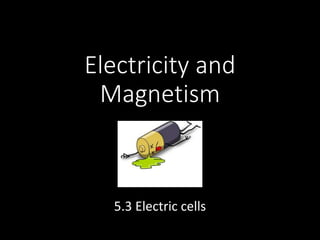Melden
Teilen

Empfohlen
Weitere ähnliche Inhalte
Was ist angesagt?
Was ist angesagt? (20)
4m electromagnetic induction__alternating_currents

4m electromagnetic induction__alternating_currents
Ähnlich wie 5.3 electric cells
Ähnlich wie 5.3 electric cells (20)
Mehr von Paula Mills
Mehr von Paula Mills (20)
Kürzlich hochgeladen
Kürzlich hochgeladen (20)
Call Girls in Dwarka Mor Delhi Contact Us 9654467111

Call Girls in Dwarka Mor Delhi Contact Us 9654467111
Web & Social Media Analytics Previous Year Question Paper.pdf

Web & Social Media Analytics Previous Year Question Paper.pdf
Presentation by Andreas Schleicher Tackling the School Absenteeism Crisis 30 ...

Presentation by Andreas Schleicher Tackling the School Absenteeism Crisis 30 ...
Z Score,T Score, Percential Rank and Box Plot Graph

Z Score,T Score, Percential Rank and Box Plot Graph
Kisan Call Centre - To harness potential of ICT in Agriculture by answer farm...

Kisan Call Centre - To harness potential of ICT in Agriculture by answer farm...
9548086042 for call girls in Indira Nagar with room service

9548086042 for call girls in Indira Nagar with room service
A Critique of the Proposed National Education Policy Reform

A Critique of the Proposed National Education Policy Reform
Measures of Central Tendency: Mean, Median and Mode

Measures of Central Tendency: Mean, Median and Mode
5.3 electric cells
- 2. Cells What is a battery? They work due to difference in electrolytic potential of chemicals. You place two terminals in an a electrolyte and the ions will be attracted to the opposite terminal.
- 3. Primary or secondary A primary cell cannot be recharged. A secondary cell can be recharged by applying an external voltage.
- 4. Electromotive Force Defining potential difference The coulombs entering a lamp have electrical potential energy, those leaving have very little potential energy. There is a potential difference (or p.d.) across the lamp, because the potential energy of each coulomb has been transferred to heat and light within the lamp. p.d. is measured in volts (V) and is often called voltage.
- 5. The p.d. between two points is the electrical potential energy transferred to other forms, per coulomb of charge that passes between the two points. Resistors and bulbs transfer electrical energy to other forms, but which components provide electrical energy?
- 6. A dry cell, a dynamo and a solar cell are some examples. Any component that supplies electrical energy is a source of electromotive force or e.m.f. It is measured in volts. The e.m.f. of a dry cell is 1.5 V, that of a car battery is 12 V
- 7. A battery transfers chemical energy to electrical energy, so that as each coulomb moves through the battery it gains electrical potential energy. The greater the e.m.f. of a source, the more energy is transferred per coulomb. In fact: The e.m.f of a source is the electrical potential energy transferred from other forms, per coulomb of charge that passes through the source.
- 9. The cell gives 1.5 joules of electrical energy to each coulomb that passes through it, but the electrical energy transferred in the resistor is less than 1.5 joules per coulomb and can vary. The circuit seems to be losing energy - can you think where?
- 10. The cell itself has some resistance, its internal resistance. Each coulomb gains energy as it travels through the cell, but some of this energy is wasted or `lost' as the coulombs move against the resistance of the cell itself. So, the energy delivered by each coulomb to the circuit is less than the energy supplied to each coulomb by the cell.
- 11. Very often the internal resistance is small and can be ignored. Dry cells, however, have a significant internal resistance. This is why a battery can become hot when supplying electric current. The wasted energy is dissipated as heat.
- 12. In the circuit below an electrical device (load) is connected in series with a cell of emf 2.5 V and internal resistance r. The current I in the circuit is 0.10 A. The power dissipated in the load is 0.23 W. Calculate (i) the total power of the cell; (ii) the resistance of the load; (iii) the internal resistance r of the cell. Question
- 13. solution (i) (2.5 x 0.10) = 0.25W; 1 (ii) 0.23 = I2 R; R = 0.23/0.12 = 23 Ω 2 (iii) power dissipated in cell = 0.02 W = I2 r; r=0.02/0.12 = 2.0 Ω or use E = IR + Ir 2.5 = 0.10 x23 + 0.10r; 2